The African-American
Liberation Movement which emerged since 1619 and particularly
from 1675 with the crushing of the Bacon Rebellion,
to the present; developed as a national democratic movement
of an oppressed minority oppressed on the basis of race,
class and gender. Some people call Africa-Americans
an �oppressed nation� or a �nation within a nation.�
But the majority of African-Americans still are attempting
to achieve equality, racial, ethnic, social, economic,
and political parity with the �Caucasian,� white working
class. White Americans still constitute seventy-seven
percent of Americans in the United States as of 2011.
Our movement for political inclusion began to take shape
when African-Americans began to move north from the
rural south during World War I when there was a labor
shortage with one million white men overseas in the
Armed Forces. Crowded into ghettos, we began to demand
representation within the inner city machines. The first
place of our representation was in Chicago which was
then the second largest concentration of African-Americans.
Oscar De Priest in 1915 became Chicago�s first alderman
(city councilman). In 1928 he represented the Chicago�s
south side district as a Republican elected to the House
of Representatives. He was the first African-American
representative since George White of North Carolina
left office in 1901. Essentially after the overthrow
of Reconstruction and the Hayes-Tilden Compromise of
1877, there were few African-American elected officials
in the country. De Priest was elected again in 1930
and 1932.
African-Americans for the most part remained loyal to
the Republican Party until about 1934, because supposedly
it was �the party of Lincoln.� As African-Americans
shifted their allegiance to the �New Deal� of Franklin
Delano Roosevelt of the Democratic Party, Arthur Mitchell
ran as a Democrat for De Priests� seat and defeated
him in 1934. William Dawson succeeded Mitchell after
Mitchell�s retirement in 1942.
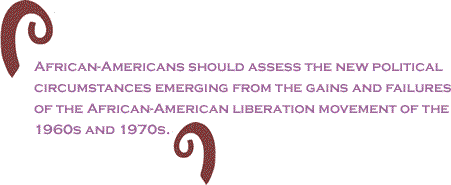
During the
1930�s in cities, African-Americans waged a �Don�t Buy
Where You Can�t Work� Movement boycotting white merchants
who would not hire African-Americans inside stores that
were located inside African-American communities. In
this same period A. Phillip Randolph, spokesman for
the Pullman Car Porters and Maids won collective bargaining
rights and recognition of the first African-American
union. All of these efforts which won economic gains
came together politically in the National Negro Congress.
A. Phillip Randolph called for the March on Washington
Movement (MOWM) to open up jobs (one million) for African-Americans
in the war industry in 1941. Roosevelt in order to ward
off the March issued Executive Order 8802 which integrated
the war industry.
Operating out of his father�s church, Abyssian Baptist
Church as assistant minister, Adam Clayton Powell Jr.
in the 1930s administered church-sponsored relief programs
that helped thousands of African-Americans in Harlem.
He led rent strikes and mass demonstrations that forced
employers, utility companies, restaurants, Harlem Hospital
and the World�s Fair in New York City to hire or promote
black workers. He had a weekly newspaper called The
People�s Voice. Essentially he was a race man. Powell
became the first African-American elected to city council
in New York. Powell also mentored Marshall Sheppard
Sr. who became prominent in Philadelphia, as well as
Reverend Leon Sullivan. Powell ran for Congress and
was elected representative of Harlem from 1941 until
1970.
In 1955, Charles Diggs Jr. was voted into Congress representing
Detroit, Michigan. In 1958 Robert Nix Sr. was elected
to Congress representing Philadelphia. In 1963 Augustus
Hawkins was elected to Congress representing Los Angeles.
In 1965 John Conyers Jr. from Detroit was elected to
Congress.
As SNCC (the Student Non-Violent Coordinating Committee)
began to change in 1966 and raised the cry of �Black
Power� and James Boggs wrote the article, �The City
is the Blackman�s Land,� the emphasis of the movement
came to elect African-American mayors in cities with
large concentrations of African-Americans. This occurred
in a period really starting in 1963, rebuilding in 1964,
exploding with Watts, LA in 1965, as the �long hot summers�
of urban rebellions in inner cities with large concentrations
of African-Americans lasted until about 1969.
The first success of the election of African-American
mayors occurred in Cleveland, Ohio with the election
of Carl B. Stokes and in Gary, Indiana of Richard Hatcher
in November, 1967. This first phase of electing black
mayors and council people represented the National Democratic
(bourgeois) stage where the mayors usually tried to
work for the interest of the African-American community.
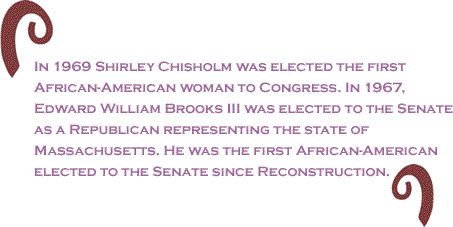
In 1969 Shirley
Chisholm was elected the first African-American woman
to Congress. In 1967, Edward William Brooks III was
elected to the Senate as a Republican representing the
state of Massachusetts. He was the first African-American
elected to the Senate since Reconstruction.
Amiri Baraka (LeRoi Jones) emerged as a cultural historian,
poet and playwright first with the publication of his
book Blues People in 1963. Baraka moved to Harlem in
1965 after Malcolm�s assassination and formed the Black
Art Theatre. Moving back home to Newark, New Jersey
he formed the Spirit House and was attacked and beaten
during the 1967 Newark Rebellion. Also in 1966 in working
with SNCC, northern activists formed Black Panther Parties.
In 1968 after the Detroit Rebellion of 1967, the Dodge
Revolutionary Union Movement (DRUM) formed.
As early as the late 1950s, there were efforts at independent
politics. Robert F. Williams had run for mayor of Monroe,
NC; before having to flee the country on a FBI frame-up
kidnapping case in 1961. The Freedom Now Party was announced
at the March on Washington in 1963. The FNP developed
a base in the Detroit area and ran a state-wide slate
in the 1964-1965 periods which was followed with James
and Grace Lee Boggs and others forming the Organization
for Black Power in 1965. The year before the Revolutionary
Action Movement (RAM) had emerged as a national organization
and in Los Angeles the US organization formed in 1965.
Amiri Baraka began to emerge after Dr. King�s assassination
as an activist (theoretician) of electing Black mayors
and other African-American elected officials. First
organizing a black political convention through the
help of the United Brothers in 1968 and then a Black
and Puerto Rican convention with the efforts of the
Committee for a Unified Newark, Baraka was successful
in helping to elect Kenneth A. Gibson, the first African-American
mayor of Newark, NJ in 1970.
1973 was a major year for the election of African-American
mayors. Coleman Young was elected in Detroit, Tom Bradley
in Los Angeles and Maynard Jackson in Atlanta, GA; elected
the first African-American mayor in the South.
Ron
Dellums was elected to Congress from the Bay Area in
1971. In 1973, Andrew Young, a previous aid to Dr. Martin
Luther King Jr. became the first African-American elected
to Congress representing the Atlanta area (South) since
the overthrow of Reconstruction in 1877.
James
Boggs in the American Revolution pages from a Negro
Workers Notebook Published by Monthly Review Press
in 1963 stated the result of the increasing use of automation
and cybernation in the production process would eliminate
the need for millions of workers and would affect African-Americans
more because we are �the last hired and first fired,
if even hired at all.� Because of racism, African-American
workers particularly unskilled males are marginalized
in the organized (unionized) workforce.
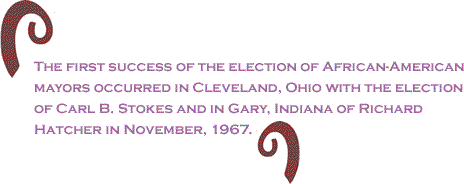
As
African-American, empowerment entered its second stage,
the internal base in the inner cities began to change
which led to African American politics from being against
the established order to being incorporated into the
Democratic Party machine. Essentially black politics
became a brokered politics with a new black political
establishment that rarely encouraged increased voter
registration or mobilization.
Reality
is constantly changing and new contradictions are constantly
being created as a old one is negated. The League of
Revolutionary Black Workers created in Detroit in 1969
mobilized mass African-American workers insurgency in
the auto plants and in the community. Their mobilizing
and organized model was used by various black labor
caucuses and movements around the country.
��the
radical challenge by labor to capital, spearheaded by
young black workers calling themselves revolutionaries
and the potential that it had to elicit support of rank-and-file
white labor, had so threatened significant sectors of
industrial capitalism that capital could not possibly
have regained its equilibrium without the aid of the
union bureaucracy. Once the ideological battle waged
by the union leadership against this new worker militancy
succeeded in discrediting and defeating the black caucuses,
capitalist restructuring commenced its great industrial
purge of black labor in the decade from the mid-1970s
to the mid-1980s.
�By
the time of the fifth and longest post-World War II
recession in 1975, U.S. industrial capitalism understood
that the gravest threat to its existence was the revolutionary
character of the black working class. Lou Turner in
his article, �Toward a Black Radical Culture of Political
Economy� suggests that the de-proletarinzation
of black workers was partially done to blunt the revolutionary
thrust of the black working class.
Thus
the U.S. capitalist class began to relocate industrial
production first in the non-union semi-rural south and
then overseas for cheaper labor and a non-militant labor
force. Automation in the production process also contributed
to the contradiction with its ability to increase productivity
with fewer workers.
At
the same time drugs i.e. marijuana, heroin and cocaine
were intensely injected into the African-American community
to thwart its revolutionary development. From 1969 to
1975 the militant wing of the black liberation movement
was wiped out by the military assault of C.O.I.N.T.E.L.P.R.O.,
the F.B.I.�s program to destroy the movement.
Shirley
Chisholm ran for president in the 1972 Democratic Party
presidential primary.
The
civil rights phase of the national black political movement
reached a peak by 1976 with the coalition it built inside
the Democratic Party around the election of Jimmy Carter.
Andrew Young gave up his seat in Congress to be succeeded
by John Lewis, to become U.S. Ambassador at the United
Nations (U.N.). The Bakke decision of 1978 began to
slow down the entrance of African-Americans through
Affirmative Action in the universities, industry and
business.
The
turning point politically, economically and culturally
came in 1980 with the election of Ronald Reagan. At
the same time the efforts at maintaining a black political
agenda began to erode as the efforts of mobilizing from
the Black Political Convention in 1972, the Black Political
Assembly in 1974 began to erode. Under the Reagan administration
the war on drugs was initiated. By 1984 with the introduction
of crack cocaine in the African-American community,
this led to mass incarceration of the African-American
urban underclass (unemployed African-American youth)
of African-American communities.
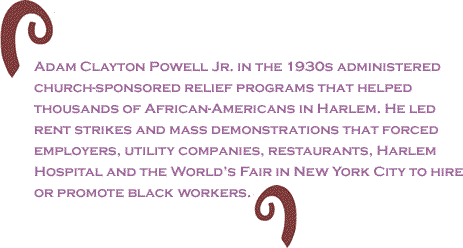
Hospitals
and universities began to expand into traditional inner
city neighborhoods. Hospital staffs and university students
replaced the urban inner city African-American working
class as consumers in the major cities. Universities
fostered the consumption of drugs as well as the drug
culture continued. As young professional, middles
class whites moved back into cities.
A
rapid class divide occurred in black America as the
black middle class for the most part moved out into
the suburbs. As a result, 1983 represented the last
year of any African-American voter insurgency against
large city machines. The classic example was the election
of Harold Washington as mayor of Chicago and to a lesser
extent of Wilson Goode as mayor of Philadelphia. With
the class divide in the African-American community,
gentrification, prison-industrial complex, the rise
of the right wing inside the Republican Party, a quasi
center conservative wing inside the Democratic Party,
globalization of the industrial labor, erosion of the
tax base African-American mayors and council, people
had to rely on business interests to finance their campaigns.
Conservative
Republicans learned to get around the 13th Amendment.�
The 13th Amendment outlaws slavery except
in prison. The U.S. capitalist class lumpenized young
African-Americans with the introduction of �crack cocaine.�
This started the �school to prison pipeline� which creates
great wealth for a sector of the white capital class
with the privatization of prisons.�
This
led to the �dumbing down� of African-American youth
in the public educational system in order to �program�
them �tracking� them from their neighborhoods to prison.
Michelle Allen has described this in her book, The
New Jim Crow.� This continues to this very hour
with 1.8 million African-Americans in prison and along
with Hispanic 7 million tied up in the legal system
in some way.
A
rapid class divide occurred in black America as the
black middle class for the most part moved out into
the suburbs. As a result, 1983 represented the last
year of any African-American voter insurgency against
large city machines. The classic example was the election
of Harold Washington as mayor of Chicago and to lesser
extent of Wilson Goode as mayor of Philadelphia. With
the class divide in the African-American community,
gentrification, prison-industrial complex, the rise
of the right wing inside the Republican party, a qusi
center conservative wing inside the Democratic Party,
globalization of the industrial labor force, erosion
of the tax base; African-American mayors and council,
people had to rely on business interest to finance their
campaigns.�
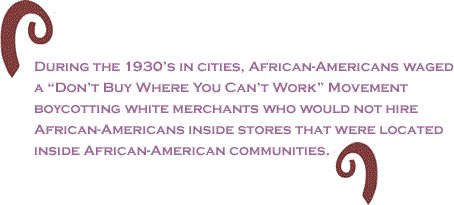
Black
political power became neo-colonialized or captured
through the Democratic Party machine politics. Two attempts
to challenge this process occurred with the Jesse Jackson
campaign for president in 1984 and again in 1988.
The
increase in black politicians continued in the late
20th
century into the 21st
century as a neo-colonial appendix of the Democratic
Party. Conditions of the African-American working class
continue to decline as African-Americans now have approximately
9,000 black elected officials across the country. African-Americans
and African-American elected officials have been fully
incorporated into the capitalist system as a neo-colonial
entity.
Think
globally and act locally: alternative self-reliant structures
and anti-imperialist (capitalist) actions:
African-Americans
should assess the new political circumstances emerging
from the gains and failures of the African-American
liberation movement of the 1960s and 1970s. African-Americans
need to attempt to work out new political forms, develop
and implement new ideas and devise coordinated strategic
approaches of building black united fronts whose center
is the radical politicalized black working class and
a people�s front that is principled anti-racist, anti-sexist
and anti-imperialist on the local level first and then
on the national and international levels.
Two
books all activists should read and study in this period
are:
Grace
Lee Boggs. The
Next American Revolution: Sustainable Activism for the
Twenty-First Century .
[Berkley. Los Angeles. London: University of California
Press, 2011]
.
[Berkley. Los Angeles. London: University of California
Press, 2011]
Pages
from a Black Radical's Notebook: A James Boggs Reader
(African American Life) . [Detroit: Wayne State University, 2011]
. [Detroit: Wayne State University, 2011]
In
every period of history there are those few who try
to define the state of the particular society and the
principal contradictions around which those who are
concerned about the society should mobilize themselves
at that particular time.
Grace
Lee Boggs says �Capitalism is the Devil.� In, �the Defending
Line of Development of Capitalism and Ruination of the
African-American Community� said the longer capitalism
exist the worst African-Americans� economic condition
would become. Through institutional racism a permanent
level of uneven equal development is maintained.
Today,
2011 the economic disparity between whites and African-American
is twenty to one. The average medium income for white
families in now twenty times greater than the medium
income of the average African-Americans� family. This
is the worst economic imbalance since the end of slavery.
 U.S.
capitalism is in crisis and has been since the 1970s.
bubble after bubble are created and crash. The last
being the Great Recession of 2008. U.S. imperialism
needed a new face and Barack Obama fulfilled that role
promising change but continuing an aggressive �pre-emptive�
imperialist strategy for the U.S. capitalist state.
The presidency of Obama, the first African-American
President of the United States has disillusioned many
activists. The U.S. capitalist government is in trillions
of dollars in debt and resources (water, natural gas
and oil) are becoming more scarce where the U.S. government
and all of Europe also in trillions of debt must militarily
through (NATO), the white united front, seize those
resources.
U.S.
capitalism is in crisis and has been since the 1970s.
bubble after bubble are created and crash. The last
being the Great Recession of 2008. U.S. imperialism
needed a new face and Barack Obama fulfilled that role
promising change but continuing an aggressive �pre-emptive�
imperialist strategy for the U.S. capitalist state.
The presidency of Obama, the first African-American
President of the United States has disillusioned many
activists. The U.S. capitalist government is in trillions
of dollars in debt and resources (water, natural gas
and oil) are becoming more scarce where the U.S. government
and all of Europe also in trillions of debt must militarily
through (NATO), the white united front, seize those
resources.
On
the local level African-American activists should become
good at isolating and uprooting and overthrowing racists,
reactionaries and (sell outs). In order to do this,
we need to look to ourselves of accepting the awesome
responsibility of leadership and young African-American
activists need to reassert the confidence that people
have the power to change the conditions of life.
African-American
activists need to run for office on a local basis to
challenge the local sell out capitalist party machine
candidates.
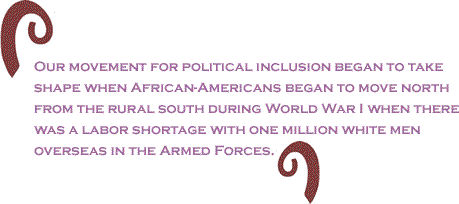
Examining
the internal contradictions in and among the people
will always be difficult and painful, but it is a necessary
step toward discovering a higher form of being. The
lives of our children who are our future depend upon
some new thinking among us.
The
black farmers say �a people who can�t feed themselves
cannot liberate themselves.� African-Americans need
to build a local self-reliant economy. We need to return
to the 1930�s, learning urban gardening, preserving
and canning of food that provides the basis of sustaining
an independent political movement.
Through dialectical humanism
or spiritualism as a community we need to re-establish
a principled responsible beloved neighborhood. By retarding
rampant �do your own thing�, selfish individualism needs
to be replaced with cooperative communal relations that
can begin by establishing communal urban gardens and
economic cooperatives.
African-American
activists should understand any viable programmatic
direction will take years to develop. African-American
activists need to develop an African-American revolutionary
internationalist youth program that becomes a movement
�school without walls� that prepares African-American
youth to fight for equality in the working class also
to build support for the working class, to build a local
self-reliant economy and independent politics. This
can be done through the teaching of revolutionary African-American
history connecting with the Algebra Project of Bob Moses,
developing higher math and technical skills leading
to a radical re-organization of the next generations.
James Boggs developed a six-point program in terms of
community building:

